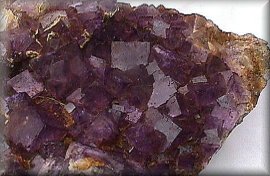

As exposed through alluvium and volcanic rubble, fluorite occurs
in veinlets and masses in a nodular to massive chert horizon
lying above what appears to be middle to late Triassic limestones
of the Natchez Pass Formation. The 76 by 46 meter exposed area
of fluorite contains numerous outcrops of tan vuggy chert and
leached fluorite with abundant crystals. The crystals vary from
free standing to massive and from colorless to purple. Colorless
crystals in the iron oxide rich areas reflect the reddish hue
of the matrix. The crystal faces range from 1 to 27mm with the
best crystals in the sub 15mm range. Heavily stepped purple
crystals to 25mm and rectangular crystals 15 by 30mm occasionally
occur. Green and yellow fluorite is seen but not in crystalized
form. The deposit was originally found while I was gold prospecting in an area not suspected of having sedimentary rocks. A window in Quarternary basalts and Tertiary volcanics expose a sequence of hydrothermally altered sediments and volcanics with anomalous gold. I am presently hand mining the deposit for crystals although discussions are in progress to produce acid and metallurgical grade fluorspar (and incidentally mine for crystals). This recently discovered deposit lies in southern Pershing County, Nevada, three hours by dirt road from the nearest towns, Lovelock and Winnemucca. At 1300 meters the property lies in dry, sparsely vegetated mountains. In the springtime cattle and a few wild horses forage for clumps of grass around the sage and bitterbrush. Summer temperature ranges upwards to 40 degrees (C), which, with the constant winds, parches the area. Winter temperatures drop to -23 degrees for a few weeks and occasional snow blankets the range. Jay W. Santos Seven Devil's Fluorite Box 871 Yerington, Nevada 89447 USA |